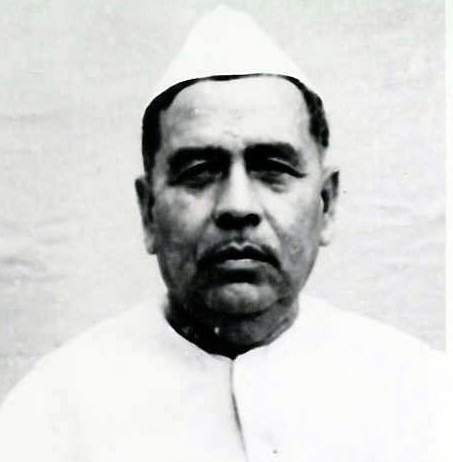 |
| MORARJI RANCHHODJI DESAI (29 FEBRUARY 1896- 10 APRIL 1995) |
 |
| KRISHNA BALLABH SAHAY (31 DECEMBER 1898-3 JULY 1974) |
11th January
1966 was a black-letter day in the history of India’s parliamentary
democracy. India’s most
loved Prime Minister Lal Bahadur Shastri died under mysterious conditions at
Tashkent, leaving behind a void that he had so
effectively filled after Pandit Jawahar Lal Nehru’s departure. In 1964 after prime minister's Nehru's death, Morarji
Desai was outflanked in the leadership contest by Nehru's protégé, Lal
Bahadur Shastri. In early 1966, the unexpected passing away of Prime Minister
Lal Bahadur Shastri only after 18 months in power resurrected Morarji Desai as
a contender for the top position.
Morarji Desai had visited Bihar on 20th October
1963 for the inauguration of the Barauni Thermal Power Station. K.B. Sahay had
taken over the reins of Chief Minister of Bihar just a fortnight ago. During
this visit, they developed a unique camaraderie that remained intact in the
coming months. This culminated in K.B. Sahay’s support for Morarji Desai’s
candidature when the latter threw in his hat for the position after Lal Bahadur
Shastri’s exit. However, the ‘Syndicate’ under the leadership of Kumaraswamy
Kamaraj along with Atulya Ghosh (Bengal), Biju Patnayak (Orissa), S.
Nijalingappa (Mysore), Neelam Sanjiva Reddy (Andhra Pradesh), Darbara Sigh
(Punjab), Dr Ram Subhag Singh (Bihar) and S.K. Patil (Maharashtra) had some
other plans. Though there were two other candidates, namely the then Home Minister
Gulzari Lal Nanda and the then Defence Minister Yahwantrao Balwantrao Chavan in
the fray, they withdrew once the name of Indira Gandhi was pushed ahead by the
‘Syndicate’.
The PTI reported on January15, 1966 that ‘the
election of Mrs Indira Gandhi to succeed Lal Bahadur Shastri as leader of the
Congress Party in Parliament and Prime Minister became assured today after a
dramatic meeting of Chief Ministers of States pledging their support to Mrs
Gandhi. The Chief Ministers who attended the meeting was V. P. Naik
(Maharashtra), K. Brahmananda Reddy (Andhra Pradesh), Sadashiv Tripathi
(Orissa), S. Nijalingappa (Mysore now Karnataka), Dwaraka Pati Mishra (Madhya
Pradesh), M. Bhaktvaslam (Madras now Tamil Nadu), Mohan Lal Sukhadia
(Rajasthan) and G. M. Sadiq (Jammu & Kashmir). Chief Minister of Uttar
Pradesh Chandra Bhanu Gupta, P.C. Sen CM of West Bengal and Ram Kishen CM of
Punjab who was not in New Delhi at the time of CM Meet reportedly held
discussion with Dwarka Pati Mishra and Kumaraswami Kamaraj and pledged their
support for Mrs Indira Gandhi, while Assam Chief Minister was represented by
Deo Kant Baruah and Fakhruddin Ali Ahmad’.
Amidst this galaxy of Chief Ministers, K. B. Sahay was the
lone CM who did not pledge his support to Mrs Indira Gandhi. He instead threw
his weight behind Morarji Desai because he considered him a better candidate
compared to Mrs Indira Gandhi, both in experience and ability. The concept of
dynastic politics though not had exactly taken roots but K. B. Sahay believed
that the projection of Mrs Indira Gandhi merely on the ground that she was the
daughter of Pandit Jawahar Lal Nehru, ignoring the merit of other senior and
meritorious candidates were not fair. Mrs Indira Gandhi was projected by the
‘Syndicate’ merely to take leverage of governance and control the politics
since Mrs Indira Gandhi was still a novice in politics- a dumb-doll (‘goongi-gudiya’)-
as Dr. Ram Manohar Lohia had christened her once.
Despite the support extended by K. B. Sahay, Morarji Desai
lost the leadership elections by 169-355 votes. The ‘Syndicate’ was soon cut to
size by Mrs Indira Gandhi who split the Congress in 1969 and walked out of
Congress to form her own party. This party was called Congress (Ruling). The
erstwhile ‘Syndicate’ leaders were forced to eat humble pie as they were forced
to return to Morarji Desai and K.B. Sahay. These old guards came to be known as
Congress (Organization). In a peculiar quirk of fate, this original Congress
comprising the old guards lost steam to maintain the momentum.
This benefitted Mrs Indira Gandhi who made the party her fiefdom, firstly as
Congress ® and later as Congress (I) in the Eighties. This led to the
inglorious extinction of the original Congress. The Congress that evolved
hereinafter was merely a bunch of unprincipled congregation bereft of its
pristine glory. It was definitely not the Congress that had brought
independence to India.
(Acknowledgement: (i) National Archives of India, (ii) Press
Trust of India News report)





No comments:
Post a Comment